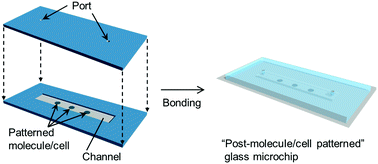A method of packaging molecule/cell-patterns in an open space into a glass microfluidic channel by combining pressure-based low/room temperature bonding and fluorosilane patterning†
Abstract
We report a fabrication method of a “post-molecule/cell patterned” glass microchip using pressure-based low/room temperature bonding in dry conditions combined with fluorosilane patterning. Multiple proteins/cells were patterned in a single channel using this method. This simple method will provide benefits for using microchips for high throughput analysis in many biological experiments.



 Please wait while we load your content...
Please wait while we load your content...